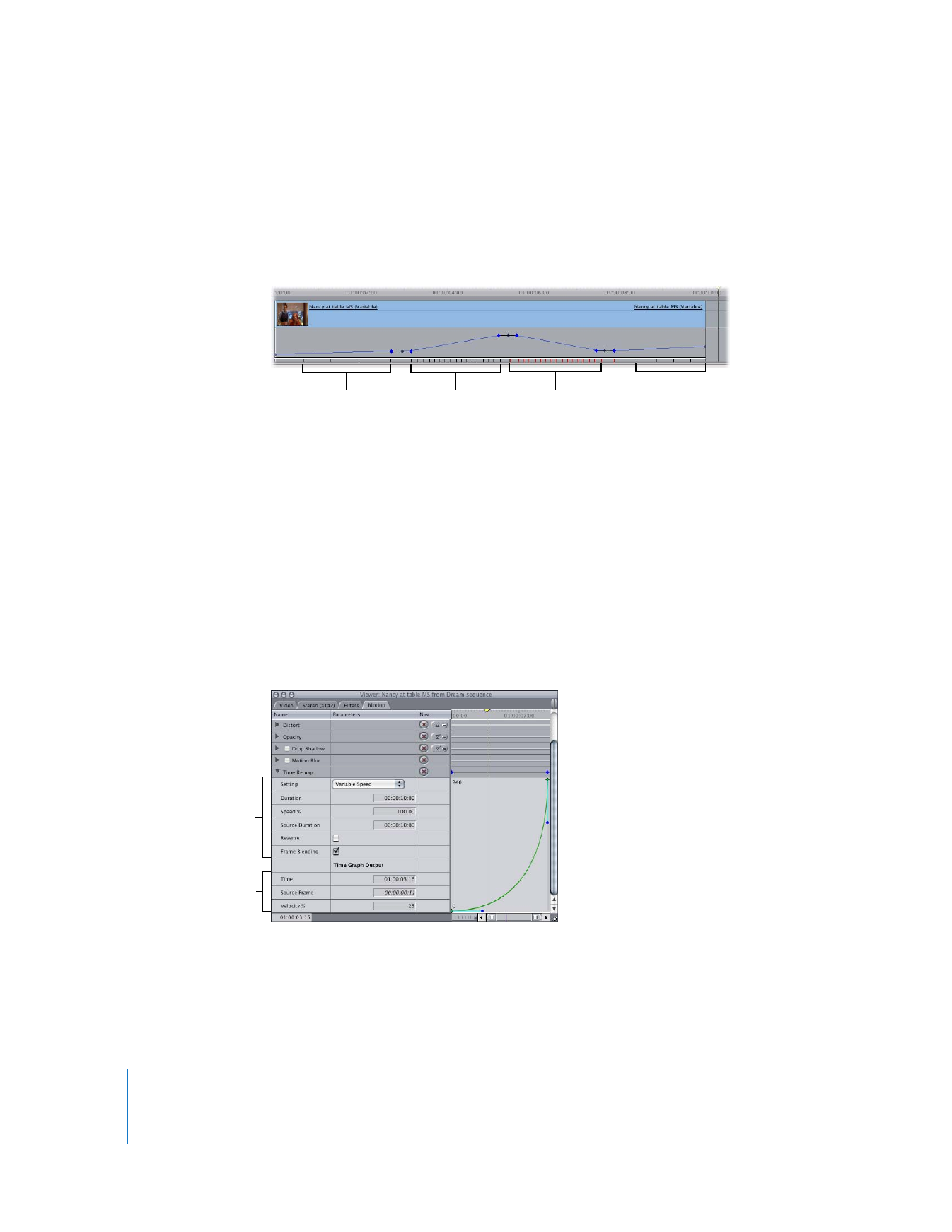
Time Remapping in the Motion Tab
You can also make adjustments to a clip’s speed using the keyframe graph in the Time
Remap parameters in the Motion tab of the Viewer. For more information about
settings in the Motion tab, see “
Adjusting Parameters in the Motion Tab
” on page 256.
Slow
Reverse
Fast
Slow
Time Remap parameters
Time Graph Output
parameters

Chapter 17
Changing Clip Speed and Time Remapping
363
II
Time Remap Parameters
 Setting: This pop-up menu allows you to choose between constant and variable speed.
 Duration: The total duration of the clip in the Timeline, accounting for constant
speed changes. This field always shows clip time mode (as opposed to source time)
and View Native Speed is always deselected.
 Speed %: The speed percentage at which the clip plays back, if a constant speed
change has been applied. If the clip is set to variable speed, the word “Variable”
appears in this field.
 Source Duration: The total duration of the clip, including unused areas at the
beginning and end of the clip. This field shows clip time mode (as opposed to source
time) and View Native Speed is always selected.
 Reverse: When selected, indicates that the clip is set to play backward.
 Frame Blending: When selected, indicates that frame blending is turned on to
smooth out the apparent motion of clips moving in slow motion.
Time Graph Output Parameters
 Time: A timecode value showing the clip’s current playhead position in the Timeline
or Viewer. If the clip is in a sequence, the current sequence timecode value is shown.
If the clip is a Browser clip, the clip’s current timecode value is shown.
 Source Frame: The timecode value of the clip frame that’s mapped to the current
time. This field always shows time with View Native Speed selected.
 Velocity %: Indicates the rate at which a clip is changing from one playback speed to
another when time remapping keyframes with Bezier smoothing are applied to a
variable speed clip.
∏
Tip: Like any other motion parameters, time remapping parameters can be saved as
motion favorites. For more information, see “
Creating Favorite Filters and Transitions
”
on page 333.
To see timecode affected by speed adjustments to the current clip, select View Native
Speed. The word native indicates that you are seeing the source timecode numbers
as they exist in the media file without any interpretation from Final Cut Pro. For more
information about timecode display options, see Volume II, Chapter 25, “Working
with Timecode.”
If View Native Speed is deselected, the timecode is affected by any speed settings
applied to the current clip. For example, if your clip has been slowed down by 50
percent, the timecode numbers increment at 50 percent speed as well.
Note: Timecode numbers appear in italics when View Native Speed is selected.

364
Part II
Effects
To see how speed settings affect the timecode view, try the following:
1
Open a clip in the Viewer.
2
Choose Modify > Speed (or press Command-J).
3
Type “25” in the Speed field, then click OK.
The clip now plays back frames from the media file at 25 percent speed. The source
timecode plays back just as slowly.
4
In the Viewer, move through the clip one frame at a time using the Left and Right
Arrow keys.
Note that the timecode numbers change once every four frames. This is because the
speed-adjusted clip holds each video frame for a duration of four frames, and the
native timecode numbers are displayed. The video frames and the timecode numbers
change only every fourth frame when viewed in the speed-adjusted clip.
5
Control-click the Current Timecode field, then choose View Native Speed from the
shortcut menu to deselect it.
Note: When View Native Speed is deselected, the timecode field is no longer italicized.
6
In the Viewer, move through the clip one frame at a time using the Left and Right
Arrow keys.
Final Cut Pro now increments the timecode at the frame rate of the clip, ignoring any
speed adjustments. This timecode is not accurate to the timecode of the media file, but
it allows you to see the timecode counter increment each time you advance a frame.
If you want to see the actual source timecode of each frame of the media file, leave
View Native Speed selected.

18
365
18